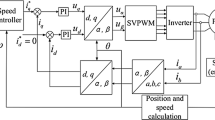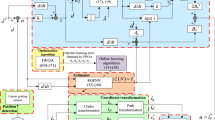Abstract
In permanent magnet linear synchronous motor systems, the nonlinear system functions in the dynamic model are difficult to obtain accurately, which leads to the reduction of system control performance. In this paper, an adaptive recurrent neural network intelligent sliding mode control (ARNISMC) strategy is proposed. The sliding mode controller is designed to improve the robustness of the system. Secondly, considering the nonlinear system function in the dynamic model of linear motor, it is approximated by recursive radial basis function neural network (RRBFNN). Then, the weight of RRBFNN is learned online by the adaptive algorithm and the approximation error of the nonlinear function is robustly compensated. The stability and convergence of the closed-loop system are proved based on the Lyapunov theory. Finally, the experimental results verify that the proposed ARNISMC not only achieves strong robustness, but also has better control accuracy than the original sliding mode control and radial basis function neural network sliding mode control method. In addition, it also shows the advantages of intelligent control.





















Similar content being viewed by others
Availability of data and materials
The data listed in the paper are obtained by MATLAB 2019 simulation and PMLSM servo system experiment, which is real and effective.
References
Cheema MAM, Fletcher JE, Xiao D, Rahman MF (2016) A linear quadratic regulator-based optimal direct thrust force control of linear permanent-magnet synchronous motor. IEEE Trans Ind Electron 63(5):2722–2733
Shao K, Zheng J, Huang K et al (2020) Finite-time control of a linear motor positioner using adaptive recursive terminal sliding mode. IEEE Trans Ind Electron 67(8):6659–6668
Bai C, Yin Z, Zhang Y, Liu J (2022) Robust predictive control for linear permanent magnet synchronous motor drives based on an augmented internal model disturbance observer. IEEE Trans Industr Electron 69(10):9771–9782
Sun G, Ma Z, Yu J (2018) Discrete-time fractional order terminal sliding mode tracking control for linear motor. IEEE Trans Ind Electron 65(4):3386–3394
Chen S-Y, Chiang H-H, Liu T-S, Chang C-H (2019) Precision motion control of permanent magnet linear synchronous motors using adaptive fuzzy fractional-order sliding-mode control. IEEE/ASME Trans Mechatron 24(2):741–752
Kang Z, Limei W (2021) Adaptive sliding mode position control for permanent magnet linear motor based on periodic disturbance learning. Electr Mach Control 25(8):132–141
Le-yang YAN, Pei-qing YE, Hui ZHANG et al (2017) Disturbance rejection for linear motor based on multi-periodic learning variable structure control. Electr Mach Control 21(1):8–13
Dezhi XU, Bomin HUANG, Weilin YANG (2021) Neural network adaptive super twist terminal sliding mode control for a permanent magnet linear synchronous motor. Power Syst Protect Control 49(13):64–71
Zhang K, Wang L, Fang X (2022) High-order fast nonsingular terminal sliding mode control of permanent magnet linear motor based on double disturbance observer. IEEE Trans Ind Appl 58(3):3696–3705
Yueneng Y, Ye Y (2018) Backstepping sliding mode control for uncertain strict-feedback nonlinear systems using neural-network-based adaptive gain scheduling. J Syst Eng Electron 29(3):580–586
Yi YU, You-gang XIAO, Cheng-zhen ZHU et al (2021) Sliding mode control of crane anti-sway positioning based on Kalman filter. Control Eng China 28(6):1049–1054
Xu B, Zhang L, Ji W (2021) Improved non-singular fast terminal sliding mode control with disturbance observer for PMSM drives. IEEE Trans Transport Electr 7(4):2753–2762
Lin H, Yin Y, Shen X et al (2022) Fuzzy logic system-based sliding-mode control for three-level NPC converters. IEEE Trans Transport Electr 8(3):3307–3319
Nair RR, Karki H, Shukla A, Behera L, Jamshidi M (2019) Fault-tolerant formation control of nonholonomic robots using fast adaptive gain nonsingular terminal sliding mode control. IEEE Syst J 13(1):1006–1017
Shao K, Zheng J, Wang H et al (2021) Tracking control of a linear motor positioner based on barrier function adaptive sliding mode. IEEE Trans Ind Inf 17(11):7479–7488
Yi-biao SUN, Ya-peng WANG, Chun-fang LIU et al (2017) Adaptive interval type-2 fuzzy sliding mode control for permanent magnet linear motor. J Shenyang Univ Technol 39(6):601–606
Sun G, Ma Z (2017) Practical tracking control of linear motor with adaptive fractional order terminal sliding mode control. IEEE/ASME Trans Mechatron 22(6):2643–2653
Yu J, Shi P, Dong W, Chen B, Lin C (2015) Neural network-based adaptive dynamic surface control for permanent magnet synchronous motors. IEEE Trans Neural Netw Learn Syst 26(3):640–645
Chen L, Yan B, Wang H et al (2022) Extreme-learning-machine-based robust integral terminal sliding mode control of bicycle robot. Control Eng Pract. https://doi.org/10.1016/j.conengprac.2022.105064
Tianhe W, Ximei Z, Hongyan J (2021) Intelligent second-order sliding mode control based on recurrent radial basis function neural network for permanent magnet linear synchronous motor. Trans China Electrotech Soc 36(6):1229–1237
Wang Z, Hu C, Zhu Y, He S, Yang K, Zhang M (2017) Neural network learning adaptive robust control of an industrial linear motor-driven stage with disturbance rejection ability. IEEE Trans Ind Inf 13(5):2172–2183
Chen Y, Zhu S, Shen M et al (2022) Event-based output quantized synchronization control for multiple delayed neural networks. IEEE Trans Neural Netw Learn Syst. https://doi.org/10.1109/TNNLS.2022.3175027
Sun Y, Xu J, Qiang H, Lin G (2019) Adaptive neural-fuzzy robust position control scheme for maglev train systems with experimental verification. IEEE Trans Ind Electron 66(11):8589–8599
Park J, Sandberg IW (1991) Universal approximation using radial-basis-function networks. Neural Comput 3(2):246–257
Sun Z, Zou J, He D et al (2022) Path-tracking control for autonomous vehicles using double-hidden-layer output feedback neural network fast nonsingular terminal sliding mode. Neural Comput Appl 34:5135–5150
Funding
This project is supported by National Natural Science Foundation of China (Grant No. 51875366).
Author information
Authors and Affiliations
Corresponding author
Ethics declarations
Conflict of interest
The authors have no relevant financial or non-financial interests to disclose.
Ethics approval
All authors of this article are compliance with Ethical Standards.
Consent to participate
All authors of this article agree to Participate.
Consent to publish
All authors of this article agree to publish.
Additional information
Publisher's Note
Springer Nature remains neutral with regard to jurisdictional claims in published maps and institutional affiliations.
Rights and permissions
Springer Nature or its licensor (e.g. a society or other partner) holds exclusive rights to this article under a publishing agreement with the author(s) or other rightsholder(s); author self-archiving of the accepted manuscript version of this article is solely governed by the terms of such publishing agreement and applicable law.
About this article
Cite this article
Fang, X., Wang, L. & Zhang, K. Adaptive recurrent neural network intelligent sliding mode control of permanent magnet linear synchronous motor. Neural Comput & Applic 36, 349–363 (2024). https://doi.org/10.1007/s00521-023-09009-7
Received:
Accepted:
Published:
Issue Date:
DOI: https://doi.org/10.1007/s00521-023-09009-7




